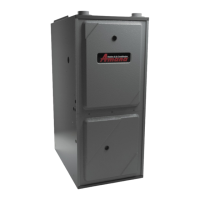8
Clearance in accordance with local installation codes, the
requirements of the gas supplier and the manufacturer's
installation instructions.
Dégaugement conforme aux codes d'installation locaux, aux
exigences du fournisseur de gaz et aux instructions
d'installation du fabricant.
-
Vent/Flue Pipe
and Combustion Air Pipe
POSITION* SIDES REAR FRONT BOTTOM FLUE TOP
Upflow 0" 0" 3" C 0" 1"
Horizontal 6" 0" 3" C 0" 6"
*M9C96 MINIMUM CLEARANCES TO COMBUSTIBLE MATERIALS
(INCHES)
C = If placed on combustible floor, floor MUST be wood only.
POSITION* SIDES REAR FRONT BOTTOM FLUE TOP
Counterflow 0" 0" 3" C 0" 1"
Horizontal 6" 0" 3" C 0" 6"
*C9C96 MINIMUM CLEARANCES TO COMBUSTIBLE MATERIALS
(INCHES)
C = If placed on combustible floor, floor MUST be wood only.
NC = For installation on non-combustible floors only. A combustible
subbase must be used for installations on combustible flooring.
-
-
CARBON MONOXIDE POISONING HAZARD
Failure to follow the steps outlined below for each
appliance connected to the venting system being placed
into operation could result in carbon monoxide poisoning
or death.
The following steps shall be followed with each appliance
connected to the venting system placed in operation,
while any other appliances connected to the venting
system are not in operation:
1. Seal any unused openings in the venting system.
2. Inspect the venting system for proper size and
horizontal pitch, as required by the National Fuel Gas
Code, ANSI Z223.1 or the Natural Gas and Propane
Installation Code, CSA B149.1-15 and these
instructions. Determine that there is no blockage or
restriction, leakage, corrosion and other deficiencies
which could cause an unsafe condition.
3. As far as practical, close all building doors and
windows and all doors between the space in which
the appliance(s) connected to the venting system are
located and other spaces of the building.
4. Close fireplace dampers.
5. Turn on clothes dryers and any appliance not
connected to the venting system. Turn on any
exhaust fans, such as range hoods and bathroom
exhausts, so they shall operate at maximum speed.
Do not operate a summer exhaust fan.
6. Follow the lighting instructions. Place the appliance
being inspected in operation. Adjust thermostat so
appliance shall operate continuously.
7. Test for spillage from draft hood appliances at the
draft hood relief opening after 5 minutes of main
burner operation. Use the flame of a match or
candle.
8. If improper venting is observed during any of the
above tests, the venting system must be corrected in
accordance with the National Fuel Gas Code ANSI
Z223.1/NFPA 54 and/or National Gas and Propane
Installation Code CSA B149.1-15.
9. After it has been determined that each appliance
connected to the venting system properly vents
when tested as outlined above, return doors,
windows, exhaust fans, fireplace dampers and any
other gas burning appliance to their previous
conditions of use.

